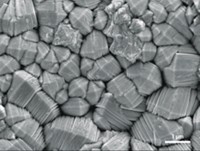Advertisement
Grab your lab coat. Let's get started
Welcome!
Welcome!
Create an account below to get 6 C&EN articles per month, receive newsletters and more - all free.
It seems this is your first time logging in online. Please enter the following information to continue.
As an ACS member you automatically get access to this site. All we need is few more details to create your reading experience.
Not you? Sign in with a different account.
Not you? Sign in with a different account.
ERROR 1
ERROR 1
ERROR 2
ERROR 2
ERROR 2
ERROR 2
ERROR 2
Password and Confirm password must match.
If you have an ACS member number, please enter it here so we can link this account to your membership. (optional)
ERROR 2
ACS values your privacy. By submitting your information, you are gaining access to C&EN and subscribing to our weekly newsletter. We use the information you provide to make your reading experience better, and we will never sell your data to third party members.
Materials
Nanotube-Polymer Mixture Prevents Biofilms
Nanomaterials: Combining carbon nanotubes with a polymer reduces the amount of nanotubes needed to kill bacteria
by Kathleen O’Neil
November 29, 2011

Carbon nanotubes can kill bacteria and prevent the formation of virulent and corrosive biofilms, probably by puncturing the microbes’ cell walls. As a result, scientists think the nanomaterials could produce antimicrobial coatings for surgical equipment and industrial piping. But nanotubes are difficult to turn into effective coatings, toxic to people at high concentrations, and expensive. Now researchers report that mixing nanotubes with a specific polymer can produce thin films that are still effective at killing bacteria, but use very low concentrations of nanotubes (Environ. Sci. Technol., DOI: 10.1021/es202374e).
When mixed into a solvent or applied to a surface alone, carbon nanotubes tend to clump up. These nanotube clumps produce uneven coatings and have relatively small surface areas exposed to the environment, decreasing their ability to kill microbes.
Previous research showed that mixing nanotubes with polymers could help break up these clumps. Researchers led by Debora F. Rodrigues of the University of Houston wanted to know what amount of nanotubes they needed to add to such a mixture to retain the nanotubes’ antimicrobial properties.
The team picked a polymer called polyvinyl-N-carbazole, because they could easily use it to form thin films on metal surfaces through electrodeposition. They tested a mixture of 3% nanotubes and 97% polymer by weight.
In a liquid suspension containing the nanotube-polymer mixture along with Escherichia coli and Bacillus subtilis cells, the nanotubes damaged or killed 94% of the E. coli and 90% of the B. subtilis. When they used the mixture to produce a thin film, the scientists found that it completely inhibited the formation of biofilms on the metal surface. The nanotube-polymer mix also killed up to 90% of both species of bacteria added to the surface, about the same effect produced by a coating of carbon nanotubes alone.





Join the conversation
Contact the reporter
Submit a Letter to the Editor for publication
Engage with us on Twitter